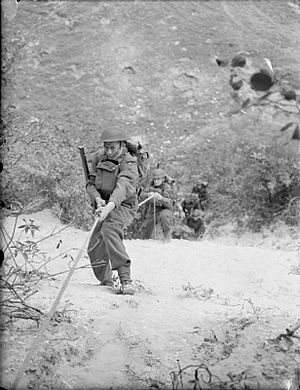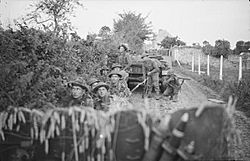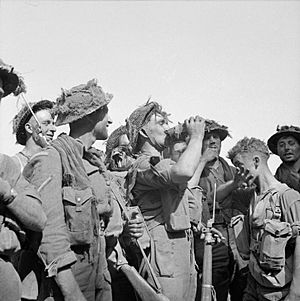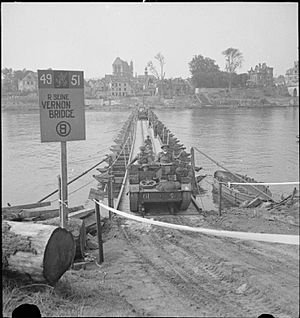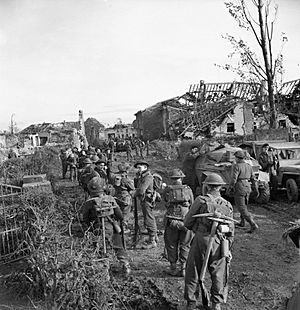43rd (Wessex) Infantry Division facts for kids
Quick facts for kids Wessex Division43rd (1st Wessex) Division 43rd (Wessex) Infantry Division 43rd (Wessex) Division/District |
|
|---|---|

Formation patch of the 43rd Division during the Second World War
|
|
| Active | 1908–1919 1920–1945 1947–1967 |
| Country | |
| Branch | |
| Type | Infantry |
| Size | Division |
| Peacetime HQ | Exeter |
| Nickname(s) | 'Fighting Wessex Wyverns' 'Yellow Devils' 'The Wicked Wyvern' |
| Engagements | Operation Epsom Operation Jupiter (Hill 112) Operation Express Operation Bluecoat (Mont Pinçon) Vernon Bridge Operation Market Garden Operation Clipper Operation Blackcock Operation Veritable Operation Plunder |
| Commanders | |
| Notable commanders |
Arthur Percival Sir Ivor Thomas Sir George Erskine |
The 43rd (Wessex) Infantry Division was a famous infantry (foot soldiers) group in Britain's Territorial Army (TA). It was first created in 1908 as the Wessex Division.
During the First World War, this division was split up. Its units fought in different places, so it never fought as one big group. It was put back together in 1920. Then, in the Second World War, it played a big part in the fighting in North West Europe from June 1944 to May 1945. The division became known for its bravery and suffered many losses.
After the Second World War, it was part of the TA again. In 1961, it changed its name to the 43rd (Wessex) Division/District. It was finally closed down in 1967.
Contents
- How the Division Was Formed
- The First World War Experience
- The Second World War: Getting Ready
- Operation Overlord: Landing in Normandy
- Operation Epsom: First Big Fight
- Hill 112: A Tough Battle
- Mont Pinçon: Capturing the High Ground
- Vernon Bridge: Crossing the Seine
- Operation Market Garden: The Road to Arnhem
- Operation Clipper: Breaking the Siegfried Line
- Operation Blackcock and Veritable
- Across the Rhine and End of War
- After the War
- Commanders of the Division
- Division Symbol
- Memorials and Tributes
- Images for kids
- See also
How the Division Was Formed
The Territorial Force (TF) was set up on April 1, 1908. This happened after a new law combined and reorganized older volunteer groups. When it started, the TF had 14 infantry divisions. One of these was the Wessex Division.
The Wessex Division was made up of TF units from the south-western parts of England. These areas included Cornwall, Devon, Dorset, Hampshire, Somerset, and Wiltshire. Its main office was in Exeter.
The First World War Experience
In July 1914, the Wessex Division was training when it received urgent orders. By August 4, the order to get ready for war arrived. The division gathered and began training for battle.
On September 24, 1914, the division was asked to go to British India. This was to replace regular army units there, so those units could go fight on the Western Front in Europe. The Wessex Division's soldiers and artillery sailed from Southampton in October. They arrived in Bombay in November.
Once in India, the division's units were spread out to different garrisons (military bases). Because of this, the Wessex Division never fought as a whole unit in the First World War. Even though it was officially called the 43rd (1st Wessex) Division in 1915, its parts served separately.
Soon, more troops were needed in other war zones. So, units from the 1st Wessex Division began to be sent to places like the Mesopotamian Front. By the end of the war, only a few units remained in India. Most of these then took part in the Third Anglo-Afghan War.
The Second World War: Getting Ready
The 43rd (Wessex) Division was reformed in 1920. It became part of the Territorial Army (TA). Before the Second World War began, the TA divisions helped create new groups. The 43rd Division helped form the 45th Infantry Division.
When war started in September 1939, the TA was called into action. The 43rd Division began training in its home area. In May 1940, it was getting ready to go to France. However, the German invasion of Europe changed everything. The 43rd (W) Division was one of the few well-equipped groups left in Britain. It was ready to stop a possible German invasion of the United Kingdom.
For the next four years, the division stayed in East Kent. It trained very hard. The area where they trained looked a lot like the countryside in Normandy. This was where they would later fight.
In 1942, the war situation changed. The 43rd Division started training for attacks to go back to Europe. Most of 1942, it was part of XII Corps. This group was led by Lieutenant-General Bernard Montgomery.
In March 1942, Major-General Ivor Thomas became the division's new commander. He was a tough leader. Some called him 'Butcher' or 'Von Thoma'. He made the 43rd (Wessex) Division one of the most trained groups in the army.
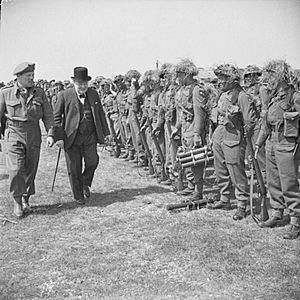
In June 1942, the 128th Infantry Brigade moved to another division. It was replaced by the 214th Independent Infantry Brigade in October 1943. This brigade had special training and stayed with the 43rd Division for the rest of the war.
Operation Overlord: Landing in Normandy
The 43rd (Wessex) Division was part of the Allied invasion of Normandy (Operation Overlord). It was supposed to land 14 days after D Day. But bad weather and shipping delays held them up. The division finally gathered near Bayeux on June 24.
Part of the 43rd (Wessex) Reconnaissance Regiment was on a ship called the Derrycunihy. It arrived off Sword Beach on June 20. High waves and enemy fire stopped them from unloading. They decided to move to Juno Beach. As the ship started, it hit a mine and split in two. Many soldiers were lost, and others were hurt. The regiment lost 183 men. It was not fully ready until the end of July 1944.
Operation Epsom: First Big Fight
The division's first battle was Operation Epsom, starting on June 26. They had to follow another division and then secure areas they captured. This meant heavy fighting. The 5th Battalion Duke of Cornwall's Light Infantry fought against German tanks on June 27. They used smaller anti-tank guns and PIATs (a type of rocket launcher).
On June 28, the 1st Battalion Worcestershire Regiment attacked. They had strong support from artillery and mortars. They pushed into houses and gardens, using PIATs against German tanks. On June 29, the 129th Brigade crossed the River Odon and dug in. A German counter-attack was stopped by the division's artillery.
Hill 112: A Tough Battle
The division's first major attack was Operation Jupiter. Their goal was to capture Hill 112. This hill had been briefly taken before but then given up. The attack on July 10 had huge support from many artillery units.
The German defenders were strong. The Wessex soldiers faced heavy fire. The 129th Brigade had a hard time on Hill 112 itself. They suffered many losses and ran into powerful Tiger I tanks. The 5th Battalion DCLI made a very brave but costly attack on the hill. They reached 'The Orchard' at the top but could not go further. They held off German counter-attacks all night.
Both sides remained dug in on the slopes. The hilltop became a "no man's land." The division had to hold its positions under constant mortar fire for 14 more days. This was compared to the heavy shelling at Passchendaele in the First World War. After this, in Operation Express on July 22, the 4th and 5th Wiltshires finally captured Maltot.
The 43rd (Wessex) Division did very well in Normandy. Many British officers thought it was one of the best divisions. General Montgomery often chose the 43rd (Wessex) and 15th (Scottish) divisions to lead his attacks. This was because other veteran divisions were tired from long service.
Mont Pinçon: Capturing the High Ground
After a short rest, the 43rd (Wessex) Division moved to attack Mont Pinçon. This was a very important high point. The attack started on July 30. The division had to fight through enemy positions and advance towards Ondefontaine.
The first day was tough, with many losses from mines. The advance was slow. On August 1, the division continued to fight its way forward. On August 2, the 129th Brigade began its attack on Ondefontaine. The 43rd Recce Regiment then helped to break through the defenses. The division was now close to Mont Pinçon.
On August 5, the 4th Wiltshires and 13th/18th Royal Hussars tanks moved through narrow lanes. They faced strong resistance. The 5th Wiltshires tried to capture a bridge at the foot of Mont Pinçon but failed that day.
A new attack was planned for August 6. But the important hill fell to a surprise attack. Two tank troops managed to get up a steep track to the top of the hill. By 6:30 PM, seven tanks were on the summit. They called for infantry support. The 4th Wiltshires and more tanks made their way up the track. By morning, the summit was firmly held. The 214th Brigade then took over from the tired troops.
After taking Mont Pinçon, the 43rd (Wessex) Division continued to advance. They crossed the Noireau River on August 15. Engineers quickly built a bridge. The main problems were mortars and booby-trapped mines. The division then chased the broken enemy, who were soon trapped in the Falaise pocket.
Vernon Bridge: Crossing the Seine
The 43rd (Wessex) Division was sent to make a river crossing at Vernon on the River Seine. They had help from bridging experts and artillery. The first group of troops arrived at Vernon on August 25. They were ready to attack that evening.
The crossing was difficult. Storm boats carrying soldiers grounded before reaching the far side. Many soldiers were lost. On the left, the 4th Somerset LI got across more easily but found they were on an island. Engineers worked under fire to build a bridge. By nightfall, the bridgehead (the area secured on the other side) was safe. The first bridge, named 'David', was finished.
The next morning, tanks were ferried across. They fought off a German tank attack. By August 28, a larger bridge, 'Goliath', was built. More tanks poured across to lead the advance. After crossing the Seine, the 43rd (Wessex) Division rested. They received new soldiers, many from another disbanded division.
Operation Market Garden: The Road to Arnhem
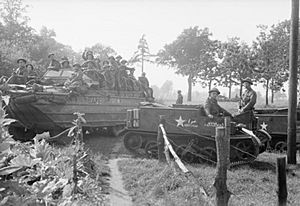
When the 43rd (Wessex) Division moved again, the war was far away. They gathered to take part in Operation Market Garden, which began on September 17. This operation involved ground troops linking up with airborne troops at river crossings up to Arnhem. The 43rd (Wessex) Division was to follow other troops. They would cross rivers if bridges were destroyed and guard the supply route to Arnhem.
The advance was slow. On September 21, the 43rd (Wessex) Division caught up with other troops at Nijmegen. But strong German forces blocked further progress. The 1st Airborne Division at Arnhem was in trouble. The 43rd (Wessex) Division was ordered to make a big effort to reach Arnhem. The Germans were dug in, and the ground was too muddy for vehicles to go off the road.
On September 23, the division worked to get support to the Polish Parachute Brigade. During the night, soldiers and engineers ferried a few hundred Poles across the river to help the 1st Airborne Division. On the night of September 24/25, more soldiers tried to cross, but suffered heavy losses. By then, the 1st Airborne Division was almost destroyed. The only option was to rescue the survivors.
On the night of September 25/26, a fake attack was made. About 2300 survivors were ferried back to the south bank. Many airborne soldiers blamed the division for being slow. However, the Corps commander, Lt-Gen Horrocks, defended them. He said they could not move vehicles off the single road, which was often cut by the Germans.
After Market Garden, the 43rd (Wessex) Division was stationed on 'the Island' (between two rivers). They guarded the western side of the area. On October 1, the Germans launched a strong counter-attack. The 4th Somerset LI and 5th Wiltshires fought them off for 48 hours. The division's artillery helped break up the attacks. On October 5, the 43rd (Wessex) handed over most of its positions to a US division. The attacks finally ended on October 6.
Operation Clipper: Breaking the Siegfried Line
The 43rd (Wessex) Division then moved east to work with the US Ninth Army. Their goal was to capture the Geilenkirchen area (Operation Clipper). This meant breaking through the Siegfried Line defenses. The attack started on November 18. The 214th Brigade attacked on the left and took its first objective. But many tanks and supply vehicles got stuck in the mud.
Without tanks, soldiers struggled forward under fire. They fought their way into villages. The traffic jams of stuck vehicles made attacks difficult. But they got into other villages, and patrols reached Geilenkirchen. After fighting off counter-attacks, Geilenkirchen was captured. But heavy rain turned the battlefield into deep mud. Soldiers had to hold their positions under heavy shelling. One wood, held by the 4th and 5th Dorsets for seven days, became known as 'Dorset Wood'.
The Germans attacked in the Ardennes (the Battle of the Bulge) on December 16. The 43rd (Wessex) Division played a small part, acting as a reserve.
Operation Blackcock and Veritable
Once the German attack in the Ardennes was stopped, the 43rd (Wessex) Division went back on the attack in early 1945. This was Operation Blackcock, to clear an area called the Roer Triangle. Bad weather stopped them from pushing further.

The 43rd Division then played a big part in Operation Veritable. This involved a month of fighting in the Reichswald forest. They captured Kleve, broke through the Siegfried Line, and took Xanten near the Rhine river.
Across the Rhine and End of War
The 43rd (Wessex) Division had a follow-up role in crossing the Rhine (Operation Plunder). Its leading brigade crossed the river on March 25, behind another division. They immediately faced combat but broke through by March 29.
During the chase that followed, the 43rd (Wessex) Division was tasked with opening a main route for the army. The division was split into five battle groups. The advance began on March 30. German rearguards were either defeated or bypassed. They crossed the Twente Canal. Troops liberated Lochem on April 1–2. The chase continued through April. It ended with the capture of Bremen and the drive into the Cuxhaven area. The fighting stopped on May 5, after the German surrender at Lüneburg Heath.
After the war, the 43rd (Wessex) Division's main office and TA units were demobilized. During the entire campaign in North West Europe, the 43rd (Wessex) Division suffered very heavy losses. Most of these, about 80% in some units, were among the infantry soldiers. From June 1944 to May 1945, the 43rd (Wessex) Division, also known as the Yellow Devils by the Germans, had over 12,500 casualties. Almost 3,000 soldiers were killed in action.
After the War
The Territorial Army was restarted on January 1, 1947. The 43rd (Wessex) Infantry Division was reformed. However, many TA units merged from 1950 onwards. In 1961, the division became a district headquarters called 43rd (Wessex) Division/District. It was finally disbanded on April 1, 1967.
Commanders of the Division
Here are some of the officers who led the 43rd (Wessex) Division:
| Appointed | General officer commanding |
|---|---|
| April 1908 | Brigadier-General William J. Kirkpatrick |
| January 1909 | Major-General Charles J. Blomfield |
| February 1911 | Major-General Colin G. Donald |
| June 1919 | Major-General Sir Charles P. A. Hull |
| September 1920 | Major-General Sir Louis J. Bols |
| September 1924 | Major-General Sir Edward Northey |
| October 1926 | Major-General Sir George D. Jeffreys |
| October 1930 | Lieutenant-General Reginald J. T. Hildyard |
| October 1934 | Major-General Baptist B. Crozier |
| December 1938 | Major-General Arthur Floyer-Acland |
| February 1940 | Major-General Arthur Percival |
| April 1940 | Major-General Robert Pollok |
| February 1941 | Major-General Charles Allfrey |
| March 1942 | Major-General Ivor Thomas |
| September 1945 | Major-General George W.E.J. Erskine |
| March 1946 | Major-General John B. Churcher |
| 1 January 1947 | Major-General George W. Symes |
| January 1949 | Major-General C.F. Charles Coleman |
| September 1951 | Major-General Cecil L. Firbank |
| September 1954 | Major-General Eric K.G. Sixsmith |
| October 1957 | Major-General Hugh A. Borradaile |
| February 1960 | Major-General John H. Cubbon |
| February 1963 | Major-General John R. Holden |
| December 1964 | Major-General Michael C.K. Halford |
Division Symbol
The kings of Wessex used a golden Wyvern on their flag. A Wyvern is a dragon with two eagle-like legs and a snake's tail. In 1935, the 43rd (Wessex) Division chose the golden wyvern on a blue square as its symbol.
Memorials and Tributes
A memorial for Hill 112 was built by the division's engineers. It is now looked after by the Commonwealth War Graves Commission. The first memorial in England was at Castle Hill, Mere, in Wiltshire. Another memorial is at Wynyard's Gap near Crewkerne, Somerset. Finally, Sir Richard Onslow gave Rough Tor on Bodmin Moor to the National Trust as a memorial. The list of those who served is in the War Memorial Chapel in Salisbury Cathedral.
A memorial stone stands in a lane named 'Somerset' in Lochem, Netherlands. It shows the Wessex Wyvern. It lists the units that liberated Lochem on April 1–2, 1945. The inscription says 'All the way from Normandy'.
Images for kids
-
43rd (Wessex) Division memorial at Castle Hill, Mere
-
43rd Division memorial at the summit of Rough Tor, Bodmin Moor
-
Liberation memorial at Lochem, Netherlands
See also
- List of British divisions in World War I
- List of British divisions in World War II
- British Army Order of Battle (September 1939)


